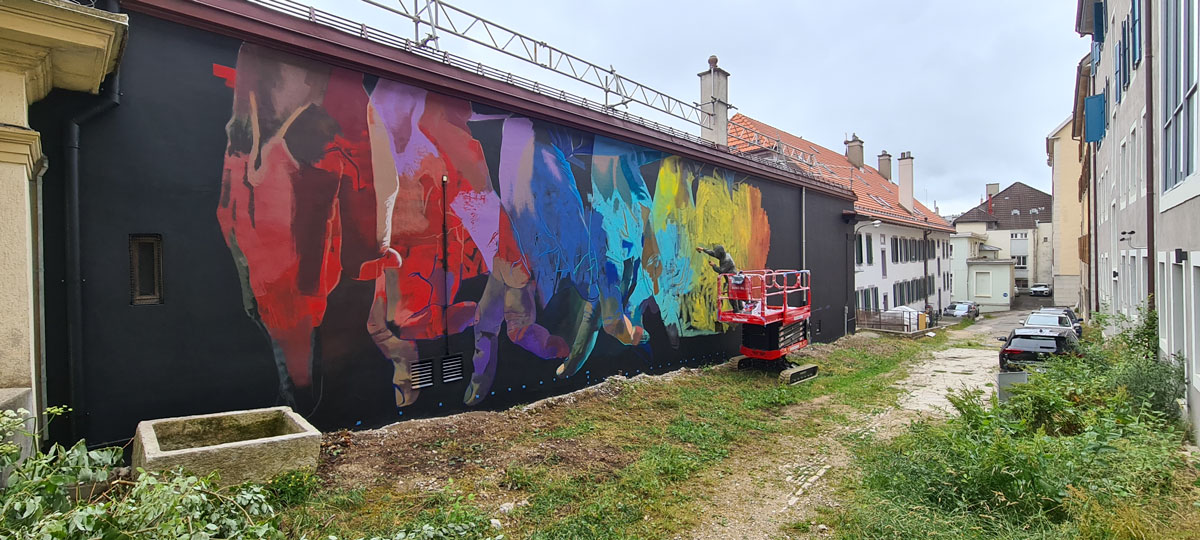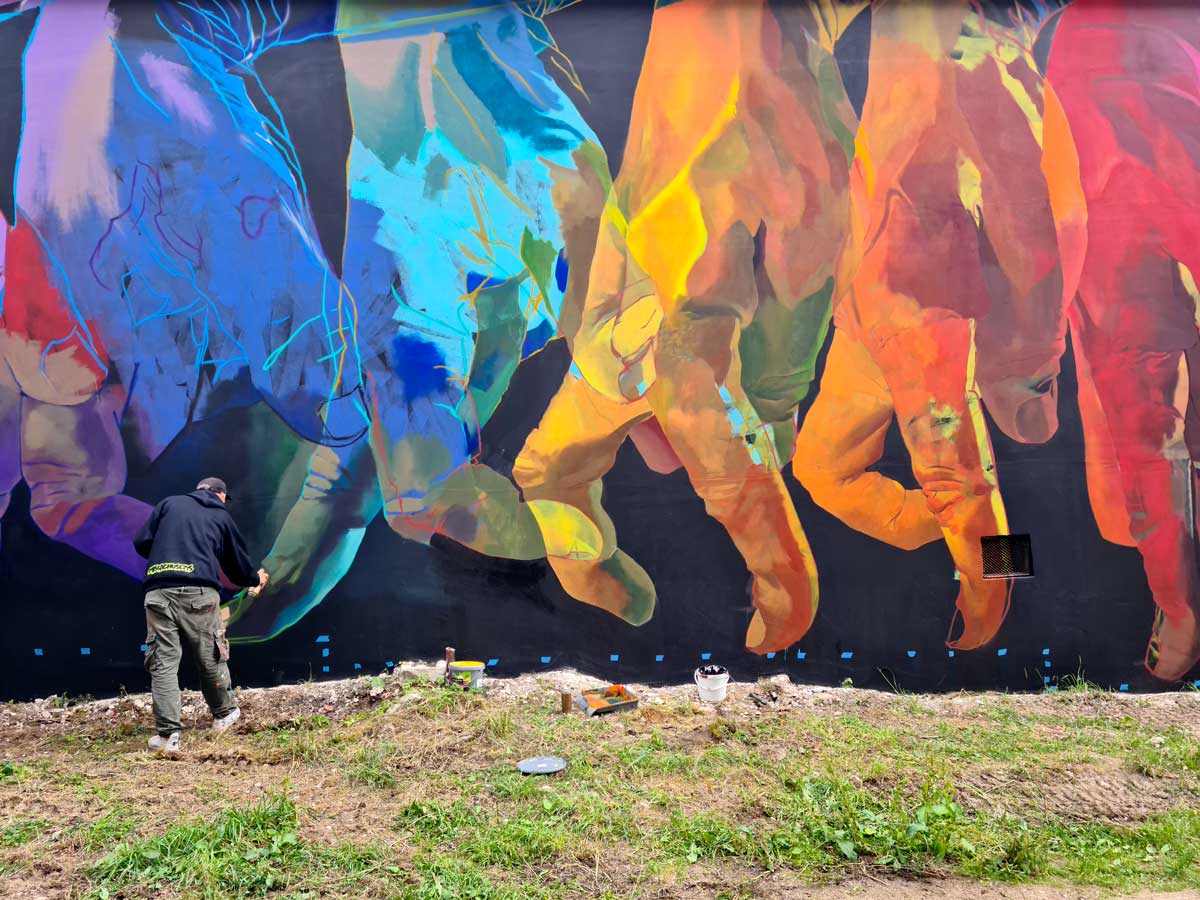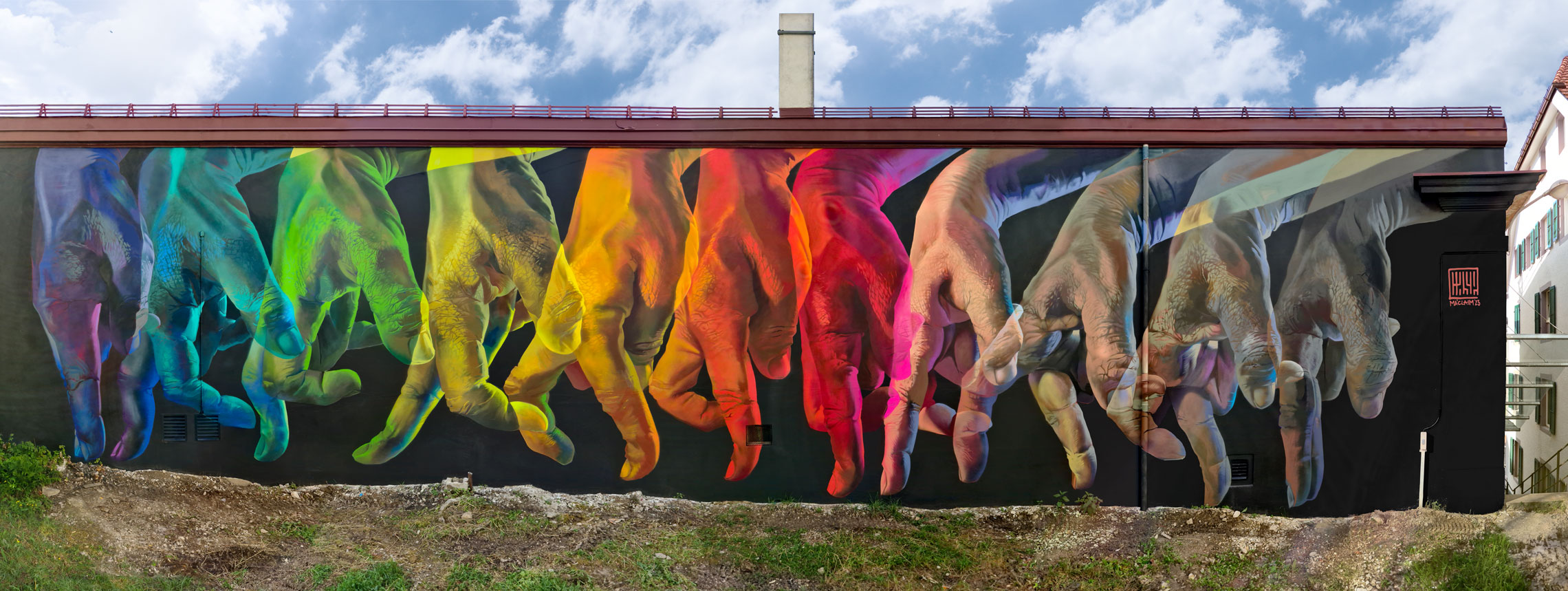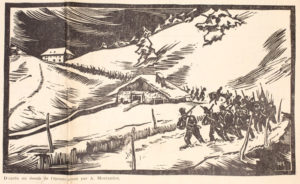Case Maclaim
[D]
- THE WORK -
Revolution
Title: Revolution
Technique: BRUSH, ROLLER, SPRAY
YEAR CREATED: 2023
Location: Marie-Anne-Calame 6 (north-west façade of the Musée des beaux-arts)
Surface area: 140 m2
Using spray, brush and roller, German artist Case Maclaim’s mural entitled « Revolution » was created in the summer of 2023, to celebrate the 175th anniversary of the Neuchâtel Revolution. It adorns the north-west façade of the Musée de Beaux-Arts of Le Locle (MBAL). Its location is no coincidence, as the MBAL is adjacent to the Hôtel de la Fleur-de-Lis, from which the revolutionary column set off on March 1, 1848.
To commemorate the advent of democracy in the canton of Neuchâtel, the exomusée didn’t want to commission a pragmatically historical fresco featuring portraits of revolutionary protagonists such as Fritz-Courvoisier (1), Ami Girard (2), or Alexis-Marie Piaget (3), or depictions of republicans hoisting the Swiss flag or men in arms. With a view to evoking past, present and future revolutions in a symbolic and timeless way, the exomusée commissioned German artist Andreas von Chrzanowski, aka Case Maclaim, who excels in creating metaphorical visuals.
In street art circles, Case Maclaim is a pioneer of photorealism. His existentialist interrogations lead him to illustrate the struggles of individuals to defend their values and dignity. His works are often based on the representation of details of the human anatomy, which he enlarges out of all proportion. For example, he takes pleasure in painting gigantic hands that, placed one after the other, break down the movement of walking. In front of these silhouettes of walkers, one has the impression of facing a parade of giants.
An allegory of the revolutionary column of 1848, this succession of hands symbolizes the courage and collective impetus that animates society during a popular, non-violent revolution. The hands march in the direction of La Chaux-de-Fonds, following the example of the Le Locle Republicans who, in 1848, left Le Locle on foot to join their peers in La Chaux-de-Fonds.
These hands miming characters are reminiscent of ombromanie, the practice of projecting silhouettes onto a screen by placing one’s hands in a beam of light. Except that Case Maclaim’s hands are not shadows. They emerge from the darkness by emitting light.
The color palette used by the artist has symbolic significance. To understand it, we can turn to a parable about light and living together. The sun emits white light. When this light passes through a glass prism, it decomposes to reveal the visible spectrum, i.e. all the colors visible to the human eye. In other words, an infinite number of colored lights, reminiscent of a rainbow. If we draw an analogy between light and human societies, we can make the following comparison: while white light is the sum of all existing colors, our society is the sum of all the individuals that make it up. This explains why the rainbow is a symbol of tolerance and diversity.
If we let our gaze wander from right to left, we can imagine that the flesh-colored hands are at the origin of the revolutionary impulse. While all the protagonists embody revolutionary values, each individual interprets and defends them in his or her own way. This notion of individuality is induced by a chromatic change.
(1) Fritz Courvoisier
Frédéric Alexandre, known as Fritz Courvoisier, born June 1, 1799 in La Chaux-de-Fonds and died in Neuchâtel on December 10, 1854, was a Swiss watchmaker, soldier and political figure. He is considered the military leader of the March 1, 1848 revolution that ended the Prussian king’s reign over the principality of Neuchâtel.
(2) Ami Girard
Ami Girard, born in Chézard-Saint-Martin on February 6, 1819 and died in Renan on April 10, 1900, was a Swiss political and military figure. Lawyer, notary, then architect, he pursued a military career, attaining the rank of colonel in 1867. An officer in the Aargau campaign of 1841, he took part in the Corps-Francs expedition against Lucerne in 1844 and the Sonderbund war in 1847. In La Chaux-de-Fonds, on the night of February 29 to March 1, 1848, he joined Fritz Courvoisier and the Neuchâtel republican leaders.
(3) Alexis-Marie Piaget Alexis-Marie Piaget, born on July 18, 1802 in Lyon (F) and died on July 1, 1870 in Neuchâtel, was a Swiss politician and member of the Radical-Democratic Party. In 1848, Alexis-Marie Piaget was appointed President of the provisional government following the March 1st Revolution. Elected to the Constituent Assembly, he is considered one of the main authors of the Neuchâtel Constitution of 1848. He then served as President of the Conseil d’Etat, the cantonal government, from 1848 to 1860. Alexis-Marie Piaget was also a member of the National Council from 1854 to 1869. A Freemason, he was a member of the L’Amitié lodge in La-Chaux-de-Fonds, belonging to the Swiss Grande Loge Alpina1.
© exomusée – August 2022 – Redaction: François Balmer – Translation: Wolfgang Carrier
Rue Marie-Anne-Calame 6 (north-west façade of the Musée des beaux-arts)
The last Lords of Neuchâtel
(4) Federal Diet
Until 1848, the assemblies of cantonal deputies were known as the « Federal Diet ».
The Neuchâtel Revolution
« Passage of the Vue des Alpes »
Engraving by A. Montandon, published in the Courrier du Val-de-Travers on February 28, 1948.
In Le Locle, on the evening of February 28, republicans hoisted a Swiss flag in front of the Hôtel de la Fleur-de-Lis. This act of insurrection provoked an altercation between the Republicans and the gendarmes. The gendarmes ordered the flag to be taken down, but the insurgents refused to comply. Faced with the anger and determination of the Republicans, the town’s military command abdicated.
A few hours later, the spark of rebellion spread to La Chaux-de-Fonds and Val-de-Travers. In both towns in the Neuchâtel mountains, revolutionary committees were organized to set up a new government. A proclamation was addressed to the people. With the Swiss flag already flying over the town halls of Le Locle and La Chaux-de-Fonds, hundreds of men in arms pledged allegiance to the Neuchâtel Republic, while promising to adopt the military discipline of the Swiss Confederation.
In Neuchâtel, the royalist government, getting worried, was forced to take urgent measures to maintain public order. One of its members was entrusted with the mission of making a round trip to La Chaux-de-Fonds and recording the people’s grievances in a report. On reading the report, the State Council realized that action was urgently needed. To avoid a bloody confrontation with the republicans, it took the wise decision to dismiss its armed troops, after paying them their wages, and to abandon to the insurrection all the posts hitherto occupied by its soldiers. At the same time, it ordered Chancellor Favarger to go to Berlin to inform the King of the situation. It also sent a letter to the Federal Directory, asking it to send federal commissioners to Neuchâtel to enforce the government’s authority. The second purpose of the letter was to convince the governments of neighboring cantons of the need to prevent republicans from their own soil from coming to the aid of the Neuchâtel insurgents.
However the revolutionaries heard about the latest resolutions of the Conseil d’État. On the morning of March 1st, two of their columns with thousand volunteers each, under the command of Fritz Courvoisier and Ami Girard, set off in the direction of the Vue-des-Alpes pass, where they halted at midday. The weather was gloomy and windy. It was snowing in flurries, and the walkers’ progress was difficult. With the help of two horse-drawn snow-removal triangles, the party made their way through the deep snow. In Val-de-Ruz, a hundred men swelled the ranks. At Malvilliers, a small royalist troop surrendered without a fight. Then, in Valangin, two cannons were captured. In the late afternoon, the small army took up position at Pierre-à-Bot, high above the city of Neuchâtel, awaiting orders from the provisional government. That evening, when no such orders were forthcoming, and the royalists seemed to offer no resistance whatsoever, the republicans entered the silent, calm capital. Supported by partisans from the Val-de-Travers and other parts of the canton, they took possession of the château without difficulty, as the royalists had fled.
That night, the new government swiftly set to work, headed by lawyer Alexis-Marie Piaget, who became the first President of the Neuchâtel Republic.
The very next day, the members of the deposed government were arrested at the home of one of their number.
With its own constitution, the Neuchâtel Republic was soon recognized by the Swiss Confederation. By modernizing laws and institutions, the new regime laid the foundations for the rule of law and democracy we know today.
© exomusée – François Balmer – Août 2023
(5) The Sonderbund Civil War
In 1847, Switzerland was shaken by a civil war that lasted 27 days. From November 3 to 29, the Sonderbund, a coalition of Catholic, conservative and secessionist cantons, confronted the majority of cantons defending the Swiss Confederation.
This civil war was the culmination of half a century of dissension between liberals in favor of a central state and conservatives committed to cantonal self-determination. Religion was also one of the reasons for the war. Liberals saw faith as a personal matter, conservatives as a public one.
When war broke out, 7 of Switzerland’s 22 cantons seceded, forming the Sonderbund coalition: Lucerne, Uri, Schwyz, Unterwalden, Zug, Fribourg and Valais. Only 2 cantons remained neutral: Neuchâtel and Appenzell Inner-Rhodes.
The war ended in defeat for the Sonderbund, which lost several battles. Isolated in the west, Fribourg was the first canton to capitulate to the Confederate army led by General Dufour. The Confederate army went on to defeat Lucerne, Valais and the original cantons.
At the end of the conflict, there were 93 people killed and around 500 wounded, a rather light toll for a civil war. Looting was virtually non-existent. Proof of the country’s community spirit, the victors remained open to the grievances of the vanquished. The outcome of the conflict played a key role in the emergence of modern Switzerland.
- THE ARTIST -
Case Maclaim
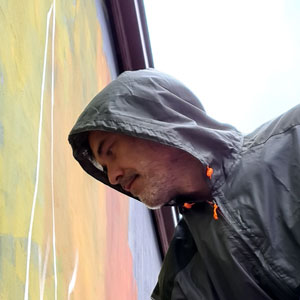
Case Maclaim, founding member of the renowned Ma’Claim Crew, originally from East Germany, has been a pioneer of photorealism for over twenty years. He mainly uses spray paint to express the power of movement through the universality of hands. « Power » and « movement » have each played a key role in the backbone of his German roots, inspiring him to communicate his strong messages of unity and power through superimposed hands. The superimposed « movement » is not only the physical movement of the body, but also the political movement, usually left without any particular context in which the viewer has to visualize the history and/or remaining emotion, in relation to his or her current situation. Having traveled to over 20 countries, he has literally left his footprints in all of them, continually leaving snippets of a language understood by all – after all, a hand gesture can say a thousand words.
To print the content of the page, please click on the printer icon.
- The exo -
on the web
Thank you for following and supporting the exomusée on Facebook, Instagram and YouTube!
